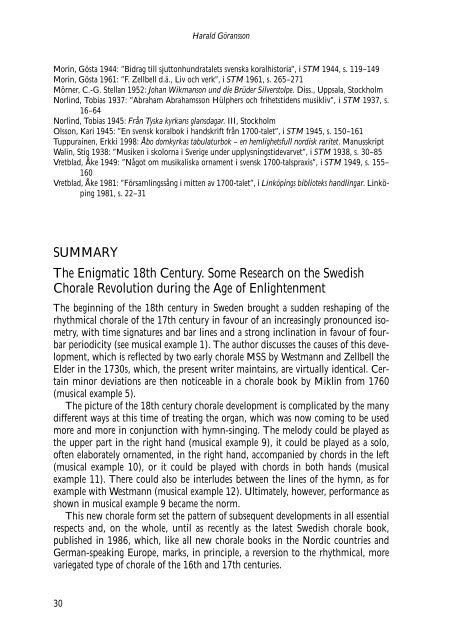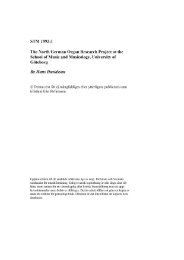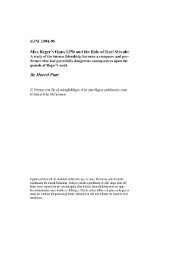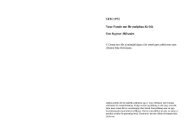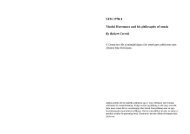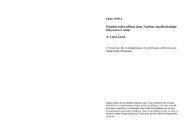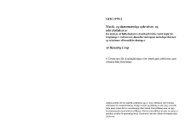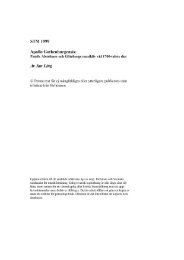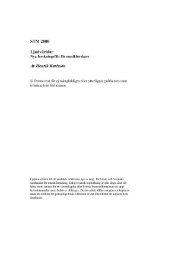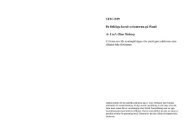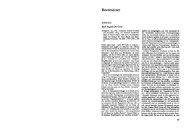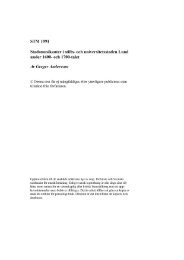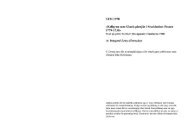Harald Göransson - Svenska samfundet för musikforskning
Harald Göransson - Svenska samfundet för musikforskning
Harald Göransson - Svenska samfundet för musikforskning
Create successful ePaper yourself
Turn your PDF publications into a flip-book with our unique Google optimized e-Paper software.
30<br />
<strong>Harald</strong> <strong>Göransson</strong><br />
Morin, Gösta 1944: ”Bidrag till sjuttonhundratalets svenska koralhistoria”, i STM 1944, s. 119–149<br />
Morin, Gösta 1961: ”F. Zellbell d.ä., Liv och verk”, i STM 1961, s. 265–271<br />
Mörner, C.-G. Stellan 1952: Johan Wikmanson und die Brüder Silverstolpe. Diss., Uppsala, Stockholm<br />
Norlind, Tobias 1937: ”Abraham Abrahamsson Hülphers och frihetstidens musikliv”, i STM 1937, s.<br />
16–64<br />
Norlind, Tobias 1945: Från Tyska kyrkans glansdagar. III, Stockholm<br />
Olsson, Kari 1945: ”En svensk koralbok i handskrift från 1700-talet”, i STM 1945, s. 150–161<br />
Tuppurainen, Erkki 1998: Åbo domkyrkas tabulaturbok – en hemlighetsfull nordisk raritet. Manusskript<br />
Walin, Stig 1938: ”Musiken i skolorna i Sverige under upplysningstidevarvet”, i STM 1938, s. 30–85<br />
Vretblad, Åke 1949: ”Något om musikaliska ornament i svensk 1700-talspraxis”, i STM 1949, s. 155–<br />
160<br />
Vretblad, Åke 1981: ”Församlingssång i mitten av 1700-talet”, i Linköpings biblioteks handlingar. Linköping<br />
1981, s. 22–31<br />
SUMMARY<br />
The Enigmatic 18th Century. Some Research on the Swedish<br />
Chorale Revolution during the Age of Enlightenment<br />
The beginning of the 18th century in Sweden brought a sudden reshaping of the<br />
rhythmical chorale of the 17th century in favour of an increasingly pronounced isometry,<br />
with time signatures and bar lines and a strong inclination in favour of fourbar<br />
periodicity (see musical example 1). The author discusses the causes of this development,<br />
which is reflected by two early chorale MSS by Westmann and Zellbell the<br />
Elder in the 1730s, which, the present writer maintains, are virtually identical. Certain<br />
minor deviations are then noticeable in a chorale book by Miklin from 1760<br />
(musical example 5).<br />
The picture of the 18th century chorale development is complicated by the many<br />
different ways at this time of treating the organ, which was now coming to be used<br />
more and more in conjunction with hymn-singing. The melody could be played as<br />
the upper part in the right hand (musical example 9), it could be played as a solo,<br />
often elaborately ornamented, in the right hand, accompanied by chords in the left<br />
(musical example 10), or it could be played with chords in both hands (musical<br />
example 11). There could also be interludes between the lines of the hymn, as for<br />
example with Westmann (musical example 12). Ultimately, however, performance as<br />
shown in musical example 9 became the norm.<br />
This new chorale form set the pattern of subsequent developments in all essential<br />
respects and, on the whole, until as recently as the latest Swedish chorale book,<br />
published in 1986, which, like all new chorale books in the Nordic countries and<br />
German-speaking Europe, marks, in principle, a reversion to the rhythmical, more<br />
variegated type of chorale of the 16th and 17th centuries.


